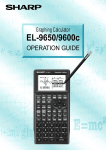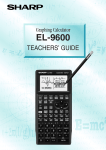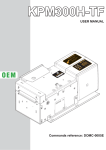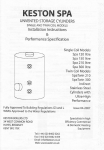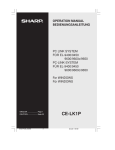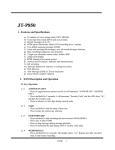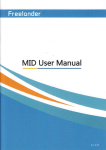Download Sharp CE-LK1P Specifications
Transcript
Graphing Calculator EL-9450/9400 OPERATION GUIDE Introduction The EL-9450/9400 was developed to meet the needs of an expanding education market and is based on three concepts: easy to teach, easy to learn and easy to use. The EL-9450/9400 has been designed with simplified operations and time-saving features, allowing teachers to concentrate on actual teaching. This manual was designed to introduce teachers to the unique features of the EL-9450/9400 using detailed operation examples. Built-in slide shows Educational tools (OHP/PC-link/Data collection) Easy to Teach Contents Easy to Learn Easy to Use Shift/Change function Equation editor Split display Large display Rapid graph Rapid window Rapid zoom Sales points Basic operation Equation editor Features Shift Change Slide show Slide show selections Graphing procedure Rapid graph Rapid window Rapid zoom P1 P2 P4 P5 P6 P7 P8 P 10 P 11 P 12 P 13 System options PC-link system Set to set communication OHP system Menu tree 1~6 Specifications P 14 P 15 P 16 P 17 P 23 S ales points 1 Large 96 x 64-dot display 2 Graph Shift/Change shows how "changing" the graph affects the equation 3 Slide Shows reduce class preparation time 4 Equation Editor shows equations just as in textbooks 5 Rapid graph/Rapid window simplify graphing procedures 6 Rapid zoom allows easy adjustment of window size 1 Basic operation Power ON/OFF ○ ○ ○ ○ ○ ○ ○ Power on Function keys Y= Use to enter equations Use to draw graphs ○ ○ ○ Power off Use to view table of function value Use to set size of viewing window CL ○ ○ ○ ○ ○ ○ Erase equations and remove error displays Use to adjust the viewing range Use to trace graphs QUIT CL ○ ○ ○ Use to enter calculation mode Cancel of previous function (Escape) Use to enter slide show mode EZ Use to operate Rapid Graph/Rapid Window and Rapid Zoom functions Names of parts 5 Display screen 1 Graphing keys 2 Power supply ON/OFF key 3 Alphabet specification key 4 Secondary function 6 Cursor movement keys 7 Clear/Quit key specification key 8 Variable enter key 9 Calculation execute key 10 Communication port for peripheral devices 2 Basic operation Guide to key use Press Press to use secondary functions (in yellow). to use the alphabet keys (in blue). SET UP menu Press SET UP . • Contents displayed on the right side of the screen are the current settings. Example: To select “sin”: To select A: ] To select “sin-1”: There may be differences in the results of calculations and graph plotting depending on the SET UP settings. ] Adjusting screen contrast Reset function • The contrast adjust screen will appear when pressing 1) When trouble occurs Press to enter the reset mode. . Press to lighten contrast. Press to darken contrast. • Use this function ( 1 or 2 ) to return all settings to the default value or to delete all data. 2) All RESET operation • If trouble still occurs, proceed as follows: 1. Press the RESET switch on the back. 2. Press . • Returns to the initial display. CAUTION Do not press CL in step 2. It will delete all data stored in the calculator. 3 E quation editor The equation editor allows equations to be viewed just as they are written in textbooks. This aids student comprehension and allows mistakes to be found quickly. Example Input the equation and see how it can be easily viewed with the equation editor. Display Key Operation 1 Clear the display. CL 2 3 4 Notes (or 6 0 a/b 2 X/T a/b X/T Select CALC and (Integral function) ) Enter the range of the integral. 1 1 Enter x 2 Complete equation input. 5 6 0 7 ) Calculate the expression. ] (or The blinking mark in the upper right side of the display indicates the expression is being calculated. ] 4 Shift (Change the location of graphs) Graph shift function helps students grasp the relationship between an equation and its graph. Shift the graph’s location without changing its shape, and the change is immediately reflected in the equation on the right side of the display. Example When the graph of y = x2 is shifted downward, how does this affect the equation? 1 SHIFT/CHANGE Display Notes Enter SHIFT/CHANGE mode. ] Key Operation If SHIFT is not already . highlighted press ] 2 Select shift. Cursor moves to the equation menu. 3 Select the equation: y = x2 and draw the graph. 4 Select the location of the shift: move cursor down twice. View the result of the shift. ] 5 y = x2 y = x2-2 ] 5 Features Change (Change the shape of the graphs) Graph change function helps students grasp the relationship between an equation and its graph. Change the shape of the graph, and the change is immediately reflected in the equation on the right side of the display. Example When the graph of y = x2 is changed, how does it affect the equation? Key Operation 1 SHIFT/CHANGE Display Notes Enter SHIFT/CHANGE mode and specified ( CHANGE ). 2 Select change. Cursor will move to the equation menu. 3 Select the equation: y = x2 and draw the graph. 4 Select the location of the change: increase the value of ycoordinates. View the result of the change. ] 5 y = x2 y = 2x2 ] 6 Features S lide show Slide show assists with teacher preparation. By selecting from the built-in options or creating your own series of slides, you can demonstrate lessons with minimum preparation time. Example Use the built-in slide show of y = x2 to show how the coordinates change as you move along the graph. Key Operation 1 2 Display Notes Specified SLIDE SHOW mode. Select the built-in menu. 3 Select y = x2 and the first slide appears. 4 Begin the slide show by pressing the cursor key. Moving between the values you can follow the changes in the graph’s coordinates, making the nature of the graph easier to understand. * View the selection of built-in slide shows on the following pages. 7 Features Built-in slide show selections 1) Y=X2 2) Y=AX+B 3) Y= X 4) Y=1/X 8 Features Built-in slide show selections 5) Y=sinX 6) Y=tanX 7) Y=cos-1X 8) Y=lnX 9 Features Graphing Procedures The EL-9450/9400 has three unique functions that simplify graphing procedures: Rapid Graph, Rapid Window and Rapid Zoom. Of course, the EL-9450/9400 supports conventional graphing procedures as well. Graphing Procedure Following outlines graphing procedures and indicates the steps where Sharp's unique functions can be used to simplify operations. These functions are introduced on the following pages. Manual Input Step 1 Rapid Graph Y= Input equation X/T x EZ ab 2 3 X/T 2 X/T Simply select from built-in menu to modify desired type of equation . Manual Input Step 2 Rapid Window EZ Set X, Y range Xmin = Xmax = Xscl = Ymin = Ymax = Yscl = (–) 3 3 (–) 1 1 5 5 1 Simply select from built-in menu to set window size. 5 Step 3 Draw graph Press Graph button to draw graph. Step 4 Manual Input Rapid Zoom EZ Adjust viewing window Amending range size Go back to Step 2 to readjust window size. Use arrows to adjust window size while viewing graph. 10 Features R apid graph Graphing has never been easier. With its full range of preset equations, rapid graph simplifies equation input. Use in conjunction with the rapid window function or with any graph created. Example Draw the graph for y = 2sin (-2x+ ) + 2 using the rapid graph function. Key Operation 1 Y= 2 EZ Display Notes Enter the equation entry mode. Enter Rapid Graph mode and view the equation-type menu. 3 Select the type of equation: Trigonometric, and view the equation format menu. 4 Select the sin equation format and view the sin equation style. 5 Select the second equation style and input. If necessary, make changes to the coefficients. 6 Draw the graph. (Note: Previous range values may affect the viewing window. To reset range values, use Rapid Window.) 11 Features R apid window Rapid window simplifies setting window size with a range of preset values. Use in conjunction with the rapid graph function or with any graph created. Example After using Rapid Graph to draw the graph of y = 2sin (-2x+ ) + 2 (refer p. 11), set the viewing window using the rapid window function. Key Operation Enter Rapid Window mode. EZ Select the No. 3 style and view the X-range menu. 3 4 (Five times) (or 5 5 Notes Enter viewing window setup mode. 1 2 Display (Six times) ) Select X-range No. 4: (-1 < X < 10 scl=1), and view the Y-range menu. Move the cursor to No. 5: (-0.5 < Y < 5 scl=0.5) (or 5 ) 7 Select the Y-range and draw the graph. 12 Features R apid zoom Rapid zoom offers one-touch adjustment of window size while viewing the graph. No more guessing or wasting class time to find optimal values for window size. Example Adjust the viewing window for y = x3 + x2 - 2x to show the entire graph. Key Operation 1 Y= X/T X/T x ab 2 2 (–) Display 3 X/T 3 3 5 1 1 (–) 1 5 Notes Create the graph y = x3 + x2 - 2x using the following conditions: X-range: xmin = -3 xmax = 3 xscl = 1 Y-range: ymin = -1.5 ymax = 1.5 yscl = 0.5 5 2 EZ Enter Rapid Zoom mode. 3 Change X-range from Ymax = 1.5 to Ymax=2. Draw the graph. 4 Repeat: Change Y-range from Ymax = 2 to Ymax=2.5. Draw the graph 5 View display (adjusted). 13 System options PC-LINK Connect the EL-9450/9400 with a PC or Macintosh computer to expand the possibilities of data exchange using PC-Link software. CE-LK1P (PC-link system) PC-Link Software PC conversion connector for IBM-PC R IBM PC or Compatibles PC-Link Software CE-450L PC conversion connector for Macintosh Macintosh R What is PC LINK? • Creates and edits EL-9450/9400 programs on a PC. • Receives and saves programs and various data from EL-9450/9400. • Makes a backup of all the contents of EL-9450/9400. • Sends programs and various data to EL-9450/9400. • Loads image data of EL-9450/9400. • Converts programs and various data files into a Text File. Converts program text files into a Program File. • Prints out programs and various data files. Procedure 1 Turn off the EL-9450/9400. 2 Connect the EL-9450/9400 to the PC by using the CE-450L, PC-Link adaptor and PC connector (see above diagram). 3 Make sure that the RS-232C (serial port) is connected to the PC. Use of the connector is determined by the shape of the PC serial port (see below chart). 4 Open PC-Link Software. Shape of PC serial port 25 pin (male) 5 Switch on EL-9450/9400. Connect the other side (25-pin side) of PC LINK adaptor to the serial port for the PC. * It is essential to use the same port for both the PC 9 pin (male) Connect the other side (25-pin side) of PC LINK adaptor to the 25-pin terminal of a converting adaptor. Also connect the other side (9-pin side) of the converting adaptor to the serial port for the PC. Operate according to the instructions on the screen. 8 pin (female) For Macintosh and the PC-Link Software. 6 Connecting procedure 14 Set to set communication Transfer data between two EL-9450/9400 calculators using the communication cable (CE-450L). EL-9450/9400 CE-450L Communication cable EL-9450/9400 Communication Procedure 3 7 Turn power on. Select SEND/ALL. Receiver ( or ) Select ‘LI’, ‘YI’ Specified LINK. 4 * mark desired data to be sent. ] ) 2 Execute Sending function. Select LINK/RECEIVE. Sender List of the SEND menu ( or 6 ] 9 ( or 5 List of sendable data will appear on screen. 8 ] 2 Plug the cable into both calculators. ] 1 ( or ) 1 Specified LINK. ) A SELECT ....................... Sends files individually as described below. 1 ALL .............................. Selects and displays all files. 2 List ............................... Selects and displays all list files. 3 GraphEq ....................... Selects and displays all graph equations. 4 Program ....................... Selects and displays all program files. 5 G_Data ......................... Selects and displays all graph data files. 6 L_Data ......................... Selects and displays all list data files. 7 Picture ......................... Selects and displays all picture data files. 8 A~Z, Ø .......................... Selects and displays all fixed memory of A to Z, and Ø B BACKUP ...................... Menu to send all file data. Use this feature to send the entire content. Select LINK/SEND. 15 OHP System Use the EL-9450/9400 OHP system with the overhead projector to make classroom presentations convenient for the whole class to see. EL-945T/94T (OHP system) AC adaptor (optional) OHP Projection Panel CE-450L OHP Panel Controller The CE-450L is included for separate use (see page 15) Procedure 1 Switch off the OHP Panel Controller. 2 Plug the cable connector of the OHP Projection Panel straight into the connection terminal of the OHP Panel Controller. (The optional AC adaptor is recommended for extended use of the OHP Projection Panel.) 3 Switch on the OHP Panel Controller. 4 Operating the OHP Panel Controller. The OHP Projection Panel display is synchronized with the display of the OHP Panel Controller. Place the OHP Projection Panel on top of the overhead projector to project images onto the screen. 5 Turn on the power to the overhead projector. 16 Menu tree 1 SET UP ( 2nd F ) SET UP A Rad FloatPt 9 Rect Decimal Eqn B DRG 1 Deg 2 Rad 3 Grad F AMSWER 1 Decimal 2 Mixed 3 Improp FORMAT ( 2nd F FORMAT C FSE 1 FloatPt 2 Fix G EDITOR 1 Eqn 2 Oneline D TAB 11 22 33 44 55 66 77 88 99 00 E COORD 1 Rect 2 Param ) A OFF OFF Connect Sequen C Y1 B EXPRES 1 ON 2 OFF 1 ON 2 OFF D STYLE1 1 Connect 2 Dot E STYLE 2 1 Sequen 2 Simul MATH ( MATH ) A CALC 1 log2 x 22 3 fmin( 4 fmax( 5 d/dx( 6∫ 7 dx B NUM 1 abs( 2 round( 3 ipart 4 fpart 5 int 6 min( 7 max( 8 lcm( 9 gcd( E ANGLE 1 2' 3" 4r 5g F INEQ 1 2 3> 4≥ 5< 6≤ C PROB 1 random 2 nPr 3 nCr 4! D CONV 1 deg 2 dms 3 xy r( 4 xy ( 5r x( 6r y( G LOGIC 1 and 2 or 3 not 4 xor 5 xnor 17 Menu tree 2 When coordinate system is Rect CALC ( 2nd F CALC When coordinate system is Param ) CALC CALC ( 2nd F CALC ) ( 2nd F LIST ) CALC 1 Value 2 Intsct 3 Minimum 4 Maximum 5 X_Incpt 6 Y_Incpt 7 Inflec 1 Value LIST A OPE 1 sortA( 2 sortD( 3 dim( 4 fill( 5 seq( 6 cumul 7 df_list 8 aug...( STAT C L_DATA 1 stoLD 2 RclLD ( STAT ) A EDIT edit list Press DRAW B MATH 1 min( 2 max( 3 mean( 4 median( 5 sum( 6 prod( 7 stdDv( 8 varian( ( 2nd F DRAW ENTER B OPE 1 sortA( 2 sortD( 3 SetList 4 ClrList C CALC 1 1_Stats 2 2_Stats D REG 01 Med Med 02 ax+b 03 a+bx 04 x2 05 In 06 log 07 abx 08 aebx 09 x-1 10 axb 11 x' 12 y' ) A DRAW 1 ClrDraw 2 Line( 3 H_Line 4 V_Line 5 T_Line( 6 Draw 7 Shade( 8 DrawInv 9 Circle( 0 Text( F PICT 1 StoPict 2 RclPict B POINT 1 PntON( 2 PntOFF( 3 PntCHG( 4 PxlON( 5 PxlOFF( 6 PxlCHG( 7 PxlTST( C ON/OFF 1 DrawON 2 DrawOFF D LINE select line type Press E G_DATA 1 StoGD 2 RclGD ENTER G SHADE 1 SET 2 INITIAL 18 Menu tree 3 ZOOM ( ZOOM ) A ZOOM 1 Auto 2 Box 3 In 4 Out 5 Default 6 Square 7 Dec 8 Int 9 Stat PROGM-COM ( 2nd F PRGM A PRGM F FORM 1 ExprON 2 ExprOFF 3 Y' ON 4 Y' OFF 5 Connect 6 Dot 7 Sequen 8 Simul ( VARS D EXP 1 10x 2 ex 3 log x 4 In x E TRIG 1 sin x 2 cos x 3 tan x 4 sin-1 x 5 cos-1 x 6 tan-1 x G RCL 1 StoWin 2 PreWin on Program screen) 1 Print 2" 3 Input 4 Wait 5 Rem 6 End VARS 1 X2 2 X-1 3 X Press ENTER F STO 1 StoWin C POWER B FACTOR Set factor of zoom B BRNCH 1 Label 2 Goto 3 If 4 Gosub 5 Return G S_PLOT 1 Plt1( 2 Plt2( 3 Plt3( C SCRN 1 ClrT 2 ClrG 3 DispT 4 DispG D I/O E COORD 1 Get 2 Send 1 Rect 2 Param D L_DATA 1 L_Data 1 2 L_Data 2 3 L_Data 3 4 L_Data 4 5 L_Data 5 6 L_Data 6 7 L_Data 7 8 L_Data 8 9 L_Data 9 0 L_Data 0 E G_DATA 1 G_Data 1 2 G_Data 2 3 G_Data 3 4 G_Data 4 5 G_Data 5 6 G_Data 6 7 G_Data 7 8 G_Data 8 9 G_Data 9 0 G_Data 0 H COPY 1 StoLine 2 RclLine ) A EQVARS Graph equation B WINDOW C STOWIN Value of window Value of stored window Press ENTER Press ENTER Press ENTER F PICTUR 1 Pict1 2 Pict2 3 Pict3 4 Pict4 5 Pict5 6 Pict6 7 Pict7 8 Pict8 9 Pict9 0 Pict0 G TABLE 1 TBLStrt 2 TBLStep 3 TBLList H STAT stat Press ENTER 19 Menu tree 4 EQ VAR ( VARS A ) A XY 1 2 3 4 5 6 7 8 9 0 B XYT Y1 Y2 Y3 Y4 Y5 Y6 Y7 Y8 Y9 Y0 01 02 03 04 05 06 WIN VAR ( VARS B BT Xmin Xmax Xscl Ymin Ymax Yscl X_Fact Y_Fact ZOOM VAR 1 Tmin 2 Tmax 3 Tstep ( VARS C ) A STOXY 1 2 3 4 5 6 B STOT Zm_Xmin Zm_Xmax Zm_Xscl Zm_Ymin Zm_Ymax Zm_Yscl STAT VAR X4T Y4T X5T Y5T X6T Y6T ) A XY 1 2 3 4 5 6 7 8 07 08 09 10 11 12 X1T Y1T X2T Y2T X3T Y3T 1 Zm_Tmin 2 Zm_Tmax 3 Zm_Tstp ( VARS H ) A XY 01 02 03 04 05 06 07 08 n x sx x xmin xmax ∑x ∑x2 PRGM B REGEQN 09 10 11 12 13 14 15 16 ∑xy y sy y ymin ymax ∑y ∑y2 RegEqn a b c r r2 R2 resid C POINTS 1 2 3 4 5 6 7 8 9 x1 x2 x3 y1 y2 y3 Q1 Med Q3 ( PRGM ) A EXEC 01 02 03 04 05 06 1 2 3 4 5 6 7 8 B EDIT 01 02 03 04 05 06 C NEW Cleate new program Press ENTER 20 Menu tree 5 STAT PLOT ( 2nd F STATPLOT ) A PLOT1 B PLOT2 C PLOT3 Stat plot1 Stat plot2 Stat plot3 Press ENTER Press ENTER Press ENTER OPTION ( 2nd F OPTION A CTRST B MEMCHK Press ENTER ( C DEL 1 List 2 GraphEq 3 Program 4 Picture 5 G-Data 6 L-Data 7 Entry D LINK 1 SEND 2 RECEIVE E RESET 1 default 2 All mem 2nd F STATPLOT on PLOT1-3screen ) A HIST SLIDE E ON/OFF 1 PlotON 2 PlotOFF ) Remain 12345bytes STAT GRAPH D LIMIT 1 SET 2 LimON 3 LimOFF B B.L. C N.P. 1 Hist 1 Broken • 2 Broken+ 3 Broken 1 Norm • X 2 Norm+_X 3 Norm _X 4 Norm • _Y 5 Norm+_Y 6 Norm _Y F MBOX 1 MBox • 2 MBox+ 3 MBox G S.D. 1 Scattr • 2 Scattr+ 3 Scattr H XYLINE 1 xyLine • 2 xyLine+ 3 xyLine ( SLIDESHOW ( 2nd F SHIFT/CHANGE D N.D. 1 NormDis E BOX 1 Box ) A B-IN 1Y 2Y 3Y 4Y 5Y 6Y 7Y 8Y 2 X AX+B X 1/X sinX tanX cos-1X lnX SHIFT/CHANGE A SHIFT 1Y 2Y 3Y 4Y 5Y 6Y 7Y 8Y 2 X X 1/X ex lnX sinX tanX X ) B CHANGE 1Y 2Y 3Y 4Y 5Y 6Y 2 X X X ex sinX tanX 21 Menu tree 6 Y= ( Y= ) RECT MODE PAR MODE Y1= Y2= Y3= Y4= Y5= Y6= Y7= Y8= Y9= Y0= X1T= Y1T= X2T= Y2T= X3T= Y3T= X4T= Y4T= X5T= Y5T= X6T= Y6T= LINK ( 2nd F OPTION A SELECT 1 All 2 List 3 GraphEq 4 Program D 1) B BACKUP 5 G_Data 6 L_Data 7 Picture 8 A Z, back up Press ENTER 22 Specifications Specifications Dimensions W x D x H (mm) 163 x 76 x 19.5 (without hardcase) Power R03 (AAA) x 4 Backup Battery CR2032 x 1 Display Size (dot) 96 x 64 Line x Characters 8 x 16 Character Size (dot) 5x7 Digits (mantissa + exponent) 10 + 2 Total Memory Size 32 KB Constant Memory 27 + last answer memory Memory Accessory Protective hard case Standard Features Graphing Function graphing Up to 10 Parametric graphing Up to 6 Zoom, Trace Table of function values Statistics Regression models 10 Scatter Plots and Histograms Box-and-Whisker Diagrams Other List Up to 6 (Maximum length : 999) Programming Trigonometry functions (including sec, csc, cot) Fraction/Decimal conversions Last entry recall Last answer recall Features unique to Sharp Equation editor, Shift/Change, Slide show (Built-in), Rapid graph, Rapid window, Rapid zoom, List grouping Peripheral CE-450L Unit-to-unit communications cable CE-LK1P PC-Link (Print screen/Data storage) EL-945T/94T OHP system (includes controller) * Design and specifications are subject to change without notice. * Some products may not be available in some countries. 23 EL-9450/9400 Graphing Calculator Distributed by: SHARP CORPORATION OSAKA, JAPAN




























